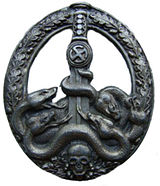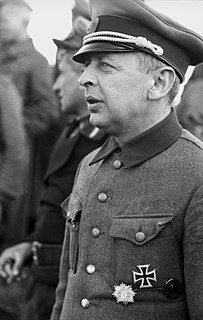Awards and Decorations of Nazi Germany were military, political and civilian decorations that were bestowed between 1923 and 1945, first by the Nazi Party and later the state of Nazi Germany.

Demyansk Shield was a World War II German military decoration awarded to military personnel who fought in the Demyansk pocket. It commemorated the successful defence of Demyansk, achieved through the use of an airbridge. The pocket of German troops had been encircled and cut off by the Red Army around Demyansk (Demjansk), south of Leningrad, during World War II on the Eastern Front. It was instituted on 25 April 1943 by Adolf Hitler. It was not bestowed after 1 July 1944.

The Wound Badge was a military decoration first promulgated by Wilhelm II, German Emperor on 3 March 1918, which was awarded to wounded or frostbitten soldiers of the Imperial German Army, during World War I. Between the world wars, it was awarded to members of the German armed forces who fought on the Nationalist side of the Spanish Civil War, 1938–39, and received combat related wounds. It was awarded to members in the Reichswehr, the Wehrmacht, SS and the auxiliary service organizations during the Second World War. After March 1943, due to the increasing number of Allied bombings, it was also awarded to wounded civilians in air raids. It was awarded when the wound was the result of enemy hostile action, with an exception being for frostbite.
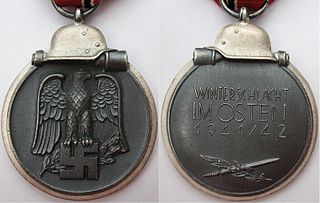
The Eastern Front Medal was a World War II German military decoration awarded to both German and Axis personnel. It was awarded to those who served on the German Eastern Front during the winter campaign period of 15 November 1941 to 15 April 1942. It was instituted on 26 May 1942 and was commonly known as the Ostmedaille or Russian Front Medal.
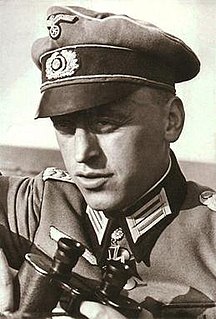
Georg von Boeselager was a German nobleman and an officer in the Wehrmacht of Nazi Germany, who led rear security operations in the Army Group Centre Rear Area on the Eastern Front, calling for harsh measures, including shooting of all males in "gang-infested areas".

The Infantry Assault Badge was a German war badge awarded to Waffen-SS and Wehrmacht Heer soldiers during the Second World War. This decoration was instituted on 20 December 1939 by the Commander-in-Chief of the German Army, Generalfeldmarschall Walther von Brauchitsch. It could be awarded to members of non-motorized Infantry units and units of the Gebirgsjäger that had participated in infantry assaults, with light infantry weapons, on at least three separate days of battle in the front line on or after 1 January 1940. When a counter offensive led to fighting, it could also apply. Award of the Infantry Assault Badge was authorized at regimental command level.

The General Assault Badge was a military decoration awarded during World War II to personnel of the German Army, Waffen-SS and Ordnungspolizei who supported an infantry attack but were not part of specific infantry units and therefore did not qualify for the Infantry Assault Badge. It was instituted by General Walther von Brauchitsch on 1 June 1940.

The Parachutist Badge was a badge awarded to qualified parachutists of the Wehrmacht and the Waffen-SS of Nazi Germany.
The Honour Roll Clasp of the Army was a decoration of Nazi Germany during World War II. A total number of 4,556 were awarded to members of the army and Waffen-SS.

The Coburg Badge was the first badge recognised as a national award of the NSDAP.
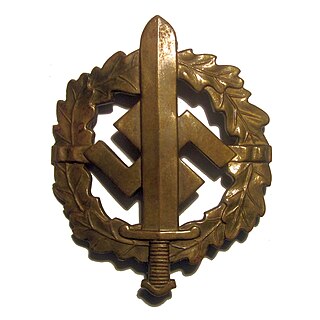
The SA Sports Badge was a decoration of Nazi Germany that was issued between the years 1933 and 1945. It was a political version of the much more generic German Sports Badge, which was also issued in great numbers by the Nazis. At its center was a 57mm high Roman broad sword, superimposed over a Nazi swastika. It was encircled by an wreath of oak leaves. It was a pin-back badge. There was a cloth version, as well.
Anti-Aircraft Flak Battle Badge was a World War II military decoration of Nazi Germany. It was instituted on 10 January 1941 by Hermann Göring in his capacity as the Commander in Chief of the Luftwaffe. The badge was awarded to servicemen of the Flak artillery who distinguished themselves in action against enemy aerial or ground attacks.
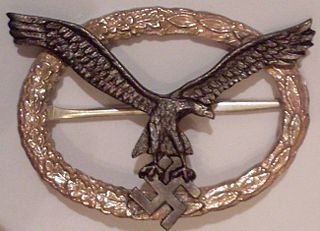
The Aircrew Badge was a German military decoration awarded to members of the German Air Sports Association, an organisation set up by the Nazi Party in March 1933 to establish a uniform basis for the training of military pilots. The German Air Sports Association was a cover organization for the future German Air Force (Luftwaffe). Its chairman was the future Commander in Chief of the Luftwaffe Hermann Göring and its vice-chairman Ernst Röhm. Since the Treaty of Versailles officially forbade Germany from building fighter planes of any sort, the German Air Sports Association used gliders to train men who were still officially civilians for the future Luftwaffe. It was the first qualification badge recognized by the Luftwaffe.
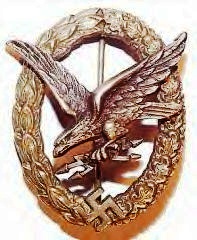
The Radio Operator & Air Gunner's Badge is a commonly accepted title for the Luftwaffen-Fliegerschützen-Bordfunker-und Bordmechanikerabzeichen. It was a German military decoration awarded to radio operators, air gunners and mechanics who were members of the German Air Force (Luftwaffe) after they completed two months training or had taken part in at least five operational flights. If wounded during an operational flight, the badge could be awarded and worn earlier. Later in June 1942, a separate badge was introduced for Air Gunners and Flight Engineers. That badge had the same qualifications.
The Air Gunner's and Flight Engineer's badge was a German military decoration awarded to air gunners, mechanics or aircrew meteorologists who were members of the German Air Force (Luftwaffe) after they completed two months training or had taken part in at least five operational flights. If one was wounded during an operational flight, the badge could be awarded earlier. For Luftwaffe members who were air gunners and mechanics this badge replaced an earlier separate badge which had been introduced back in 1935. The qualifications for the two badges were the same for recipients.
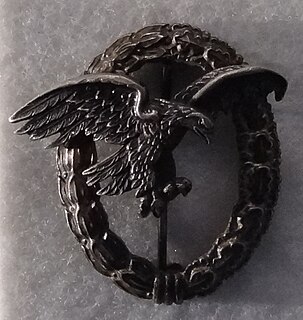
The Observer's Badge was a German military decoration that was awarded before and during World War II to members of the German Air Force (Luftwaffe). They qualified for the badge after completing two months of qualifying service and five operational flight's in the role of observer, navigator or bombardier; also, it could be awarded after a member of the German Air Force was wounded while acting in the capacity of an observer during a qualifying flight. It was worn on the left breast tunic pocket of an air force or political uniform tunic. A citation was issued with the awarded badge. Thereafter, Luftwaffe service personnel who had already been awarded the Pilot's Badge and Observer's Badge could qualify for the Pilot/Observer Badge. After 31 July 1944 the regulations were changed and the recipient had to have held both qualification certificates for at least one year to qualify for the Pilot/Observer Badge.

Max von Schenckendorff was a general in the Wehrmacht of Nazi Germany during World War II. He was the commander of Army Group Rear Area behind Army Group Centre from March 1941 until his death. He is best known for organising the Mogilev conference, in which Wehrmacht and SS officers discussed "bandit fighting" tactics, meaning the mass murder of Jews and other real or perceived enemies. The conference resulted in an intensification of the genocide that was already taking place in Army Group Centre Rear Area.
Army Group North Rear Area was one of the three Army Group Rear Area Commands, established during the 1941 German invasion of the Soviet Union. Initially commanded by General Franz von Roques, it was an area of military jurisdiction behind Wehrmacht's Army Group North.

Bandenbekämpfung is a German-language term that means "bandit fighting" or "combating of bandits". In the context of German military history, Bandenbekämpfung was an operational doctrine that was part of countering resistance or insurrection in the rear area during wars. Another more common understanding of Bandenbekämpfung is anti-partisan warfare. The doctrine of "bandit-fighting" provided a rationale to target and murder any number of groups, from armed guerrillas to the civilian population, as "bandits" or "members of gangs". As applied by the German Empire and then Nazi Germany, it became instrumental in the genocidal programs implemented by the two regimes, including the Holocaust.



